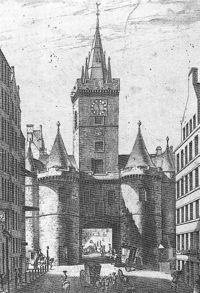Annotation:Nether Bow has Vanished (The): Difference between revisions
No edit summary |
m (Text replacement - "garamond, serif" to "sans-serif") |
||
| Line 1: | Line 1: | ||
=='''Back to [[{{BASEPAGENAME}}]]'''== | =='''Back to [[{{BASEPAGENAME}}]]'''== | ||
---- | ---- | ||
<p><font face=" | <p><font face="sans-serif" size="4"> | ||
'''NETHER BOW HAS VANISHED, THE.''' Scottish, Reel, Strathspey. John Glen (1891) finds the earliest printing of this tune in musician and music publisher Robert Bremner's 1768 2nd collection (p. 104). The title refers to what was the last surviving gate or Port in the medieval wall of old Edinburgh, the Nether Bow. It was originally constructed in the year 1369 in the High Street, now part of the Royal Mile, on the boundary between Edinburgh and Canongate. It survived until 1764 (just prior to Bremner's publication) when it was demolished to improve traffic flow in the Royal Mile. | '''NETHER BOW HAS VANISHED, THE.''' Scottish, Reel, Strathspey. John Glen (1891) finds the earliest printing of this tune in musician and music publisher Robert Bremner's 1768 2nd collection (p. 104). The title refers to what was the last surviving gate or Port in the medieval wall of old Edinburgh, the Nether Bow. It was originally constructed in the year 1369 in the High Street, now part of the Royal Mile, on the boundary between Edinburgh and Canongate. It survived until 1764 (just prior to Bremner's publication) when it was demolished to improve traffic flow in the Royal Mile. | ||
[[File:netherbow.jpg|200px|thumb|left|Nether Bow Port in the 18th century.]] | [[File:netherbow.jpg|200px|thumb|left|Nether Bow Port in the 18th century.]] | ||
| Line 10: | Line 10: | ||
<br> | <br> | ||
</font></p> | </font></p> | ||
<p><font face=" | <p><font face="sans-serif" size="4"> | ||
''Source for notated version'': | ''Source for notated version'': | ||
<br> | <br> | ||
<br> | <br> | ||
</font></p> | </font></p> | ||
<p><font face=" | <p><font face="sans-serif" size="4"> | ||
''Printed sources'': Bremner ('''A Second Collection of Scots Reels or Country Dances'''), 1768; p. 104. | ''Printed sources'': Bremner ('''A Second Collection of Scots Reels or Country Dances'''), 1768; p. 104. | ||
<br> | <br> | ||
<br> | <br> | ||
</font></p> | </font></p> | ||
<p><font face=" | <p><font face="sans-serif" size="4"> | ||
''Recorded sources'': <font color=teal>Puirt a Baroque - "Return of the Wanderer." </font> | ''Recorded sources'': <font color=teal>Puirt a Baroque - "Return of the Wanderer." </font> | ||
</font></p> | </font></p> | ||
Revision as of 14:28, 6 May 2019
Back to Nether Bow has Vanished (The)
NETHER BOW HAS VANISHED, THE. Scottish, Reel, Strathspey. John Glen (1891) finds the earliest printing of this tune in musician and music publisher Robert Bremner's 1768 2nd collection (p. 104). The title refers to what was the last surviving gate or Port in the medieval wall of old Edinburgh, the Nether Bow. It was originally constructed in the year 1369 in the High Street, now part of the Royal Mile, on the boundary between Edinburgh and Canongate. It survived until 1764 (just prior to Bremner's publication) when it was demolished to improve traffic flow in the Royal Mile.

Nether Bow has Vanished is also the name of a Scottish Country Dance (RSCDS Book 13), to which other tunes are now played.
Source for notated version:
Printed sources: Bremner (A Second Collection of Scots Reels or Country Dances), 1768; p. 104.
Recorded sources: Puirt a Baroque - "Return of the Wanderer."
